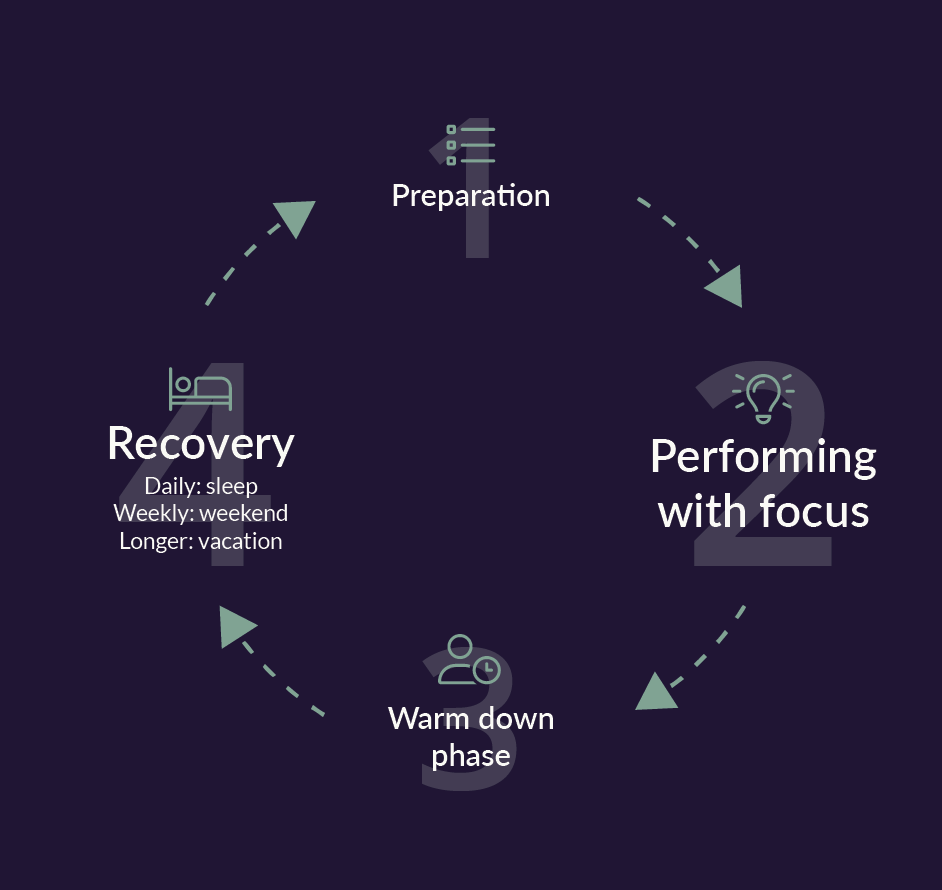My 3 interesting things for you this month…
1. Developing a resilient team
This month I did something new!
I delivered resilience training, an interesting topic but not one I’ve covered before. It included many of the tools and techniques I already use and share within my coaching and other training, but never wrapped up together.
Resilience is being able to get through difficult stuff in a healthy, sustainable way.
There are lots of webinars and content out there on this. However the team I was working with was already pretty resilient: they work for a results orientated company in a high performance culture
Many of the attendees had thrived in that environment for 10+ years, so what could I bring that they hadn’t already figured out!?
The thing that resonated most was being aware of how we can use a “4 Stages of a High-Performance Routine” to maintain sustainable resilience.
Athletes know they need recovery to maintain high performance – so how are we consciously doing the same in our roles?
The 4 stages of high performance routine looks like this… with stages 2 and 4 taking more time and/or focus relative to the others.

1. Preparation Phase
Purpose: Mentally prepare, narrow focus and build clarity to improved focus and impact, reduce distraction.
Outcomes: Routine, priority identification, preparation for meetings, team preparation.
Examples: Morning routines, planning, prioritising, making good habits easier.
2. Performing with Focus
Purpose: Work on highest priorities with maximum focus for higher quality outcomes and increased impact.
Outcomes: Knowing best times of day, minimising distractions, working to deadlines, minimising team noise.
Examples: Changing environment (find a spare desk), protecting prime times, controlling notifications, delegating, using techniques like Pomodoro.
3. Warm Down Phase
Purpose: Transition away from work and close open loops to optimise recovery time and reduce anxiety.
Outcomes: Cut-off time, shutdown routine, wind down routine, team review.
Examples: Setting evening cut-offs, creating shut down rituals, limiting bright lights later on.
4. Recovery Phase
Purpose: Replenish energy and gain perspective for better well-being, sustainable performance and clearer thinking.
Outcomes: Seeing recovery as a driver of performance, scheduling recovery, regular exercise, healthy sleep.
Examples: Scheduling recovery, high-contrast activities (doing something different), mini pit-stops (breaks during the day), creating and sticking to good boundaries.
Where I see this being particularly useful is around transformation and change initiatives.
How are we enabling our teams to have time to recover and prepare accordingly?
Have a think about how this is working in your team, and if it’s not, how you can change things for the better.
2. Writing enticing job descriptions
Many of you have noticed that the finance hiring market (in the UK at least) is slow at the moment, particularly for more senior level roles.
Personally, I expect this to all start moving again post last week’s UK election and once interest rates start to fall (expected at some point over H2).
Once this picks up, expect there to be a lot of movement again – potentially leading to gaps on our teams to fill!
One thing we can start thinking about now for any gaps, is great job descriptions.
I know I don’t have to tell any of my readers this right now – but obviously you’re using ChatGPT to help you create at least the first 70-80% of the job description (!?).
This will help to cover all the important points, use clear concise language and make sure it’s as good as anyone else’s who will also be using ChatGPT. Remember its usually easier to edit than create!
Then we can spend our time on the real magic, and the reason that many potentially great job descriptions fall down. They don’t consider enough of the WIIFM (what’s in it for me) for the reader.
For example, a client of mine working for a really exciting fast growing company asked me to review a job description.
I know the role will be great, with an excellent manager and great prospects. But the thorough and accurate JD actually read as hard and pretty boring – with no clear upside for the candidate.
Another had a great job description, but no mention of the opportunity for the candidate to massively expand their scope over the next 2 years – the hiring manager’s #1 goal for the role.
I’m not suggesting making things up or exaggerating, but its key in a competitive market to talk about why the role is great – beyond the key responsibilities. Think about growth and development, the manager (remembering 75% employees ‘leave managers’ not jobs!), opportunities for progression (without promising anything), team culture, and all the other great things of where you work.
Finally, if you really can’t think of any… maybe when the market picks up it’s time for you to look for a new job. If so, give me a shout!
3. The rule of 40
I came across this concept pretty recently.
Perhaps its old hat for those who’ve been around start-ups for a while, but if not, I thought I’d share!
It’s a great simple principle that enables strategic thinking and decision making.
The Rule of 40 is a metric commonly used to evaluate the performance of scale-ups, particularly in the SaaS (Software as a Service) industry.
It provides a simple way to balance growth and profitability, which are both critical for long-term success.
Here’s how it works and why it’s important for scale-ups:
How the Rule of 40 Works:
1. Calculation: The Rule of 40 states that the combined value of a company’s growth rate and profit margin should be at least 40%. The formula is…
Rule of 40 Score = Growth Rate (%) + Profit Margin (%) = ideally >40%
Growth Rate: This is typically measured as year-over-year revenue growth.
Profit Margin: This is usually the operating margin, which can be either positive or negative.
2. Example Calculation:
If a company’s annual revenue growth rate is 30% and its profit margin is 10%, the Rule of 40 score would be: 30%+10%=40%30\% + 10\% = 40\%30%+10%=40%
If the company is growing very rapidly but is not yet profitable, say with a growth rate of 50% and a profit margin of -5%, the Rule of 40 score would be: 50%−5%=45%50\% – 5\% = 45\%50%−5%=45%
So why does it matter?
1. Balancing growth and profitability: The Rule of 40 provides a balanced view of a company’s health, recognising that both growth and profitability are important. Fast-growing companies often sacrifice short-term profitability for future gains, while more mature companies might focus on profitability.
2. Investor appeal: Investors often use the Rule of 40 to assess whether a company is effectively balancing its growth and profitability. A company that meets or exceeds the Rule of 40 is typically seen as a better investment opportunity because it demonstrates a balanced approach to scaling up.
3. Strategic decision-making: For management, the Rule of 40 can guide strategic decisions, helping to determine the right mix of investment in growth versus achieving profitability. It can inform decisions on spending, hiring, and expansion.
4. Benchmarking: It serves as a benchmark to compare performance against other companies in the same industry. This can be particularly useful for identifying competitive advantages or areas for improvement.
Whatever size of business you’re in, having principles you can apply to avoid having to make lots of individual decisions can be really useful.
What principles could you apply more of in your role?
Want more insights?
Sign up to my interesting things newsletter here to get tips like this and more.


